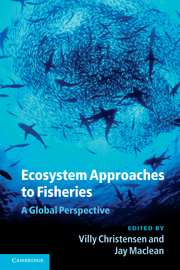Book contents
- Frontmatter
- Contents
- List of contributors
- Foreword
- Preface
- Acknowledgments
- 1 Introduction: toward ecosystem-based management of fisheries
- I Life in the oceans
- II Evaluating impact on marine life
- 5 How much fish is being extracted from the oceans and what is it worth?
- 6 Fishing down food webs
- 7 Aquaculture up and down the food web
- 8 Beyond food: fish in the twenty-first century
- 9 The shifting baselines syndrome: perception, deception, and the future of our oceans
- III Managing living resources
- IV The human side
- V Impacting policy
- Index
- References
6 - Fishing down food webs
Published online by Cambridge University Press: 05 June 2012
- Frontmatter
- Contents
- List of contributors
- Foreword
- Preface
- Acknowledgments
- 1 Introduction: toward ecosystem-based management of fisheries
- I Life in the oceans
- II Evaluating impact on marine life
- 5 How much fish is being extracted from the oceans and what is it worth?
- 6 Fishing down food webs
- 7 Aquaculture up and down the food web
- 8 Beyond food: fish in the twenty-first century
- 9 The shifting baselines syndrome: perception, deception, and the future of our oceans
- III Managing living resources
- IV The human side
- V Impacting policy
- Index
- References
Summary
INTRODUCTION
Fishing affects all levels of biological organization, from individuals to populations, affecting their demographic and genetic characteristics, as well as communities and ecosystems, (e.g., Hutchings, 2000; Law, 2000; Jackson et al., 2001; Daskalov, 2002; Pauly et al., 2002). Among the many effects of fishing, those referring to the marine ecosystem (i.e., trophic structure and energy flow within the ecosystem) have received particular attention in recent years.
This attention is in part because of the pioneering work of Pauly et al. (1998a). These authors used the world fisheries catch statistics (published annually by the Food and Agriculture Organization of the United Nations, FAO) and the trophic level (TL; Froese, this volume) of all species or groups of species contributing to the catches and showed that the mean trophic level of the catches had declined significantly, by about 0.5 TL, over a 50-year period. This decline was observed for global marine catches as well as for the majority of the different FAO subareas of the Atlantic, Indian, and Pacific Oceans, and the Mediterranean and Black Seas. This process, which, as will be shown here, has had a strong impact on fisheries science, is now known as “fishing down marine food webs” (FDFW). In fact, FDFW gave “flesh and bones” to something that many fisheries scientists intuitively had in their minds, while formal descriptions were few (Christensen, 1996).
FDFW was very enthusiastically received by the media (Baron, this volume) as well as by a large part of the scientific community.
- Type
- Chapter
- Information
- Ecosystem Approaches to FisheriesA Global Perspective, pp. 72 - 88Publisher: Cambridge University PressPrint publication year: 2011
References
- 7
- Cited by



